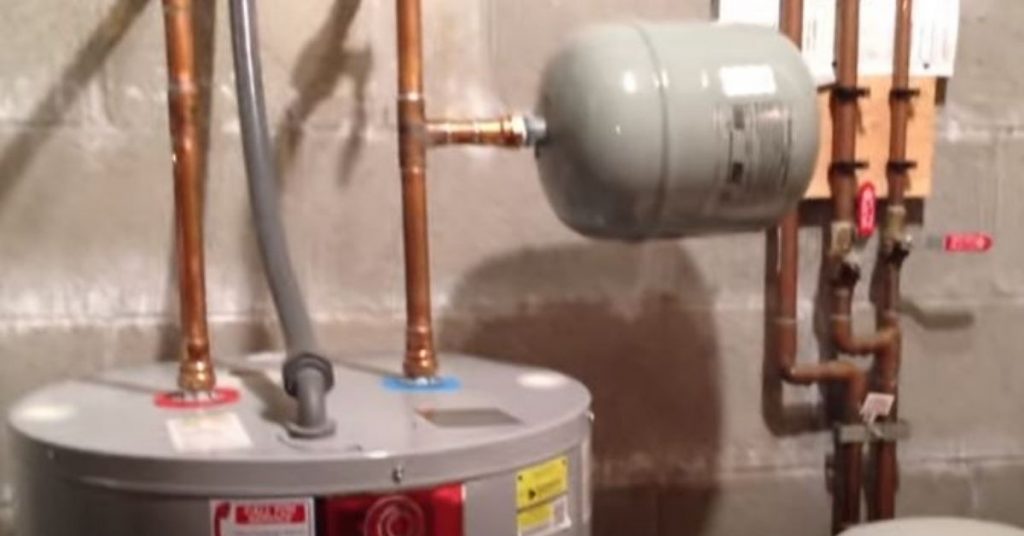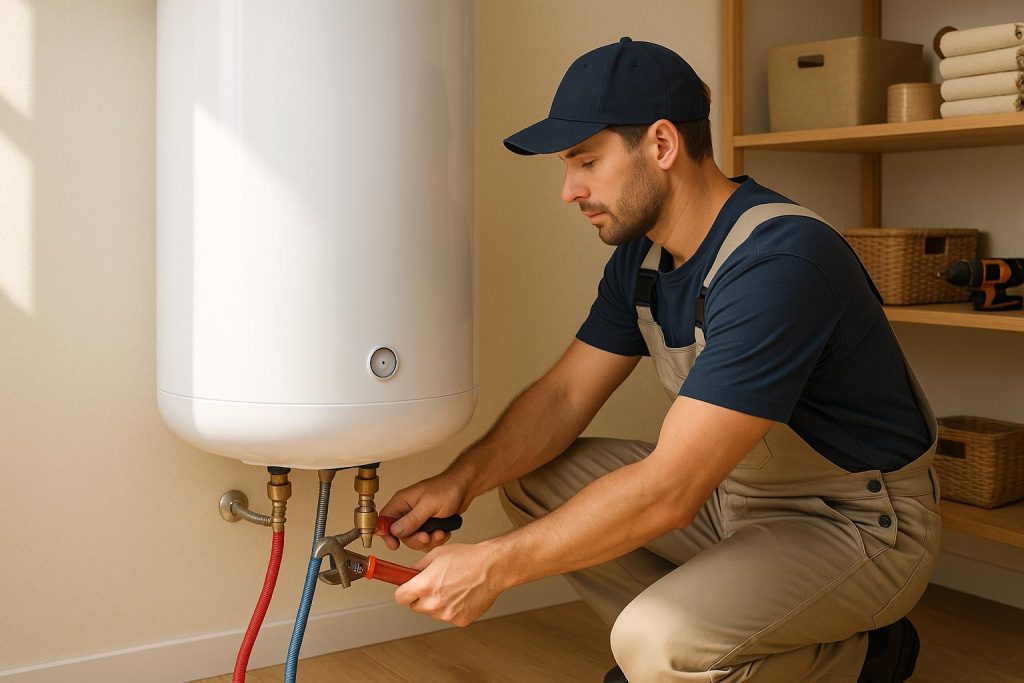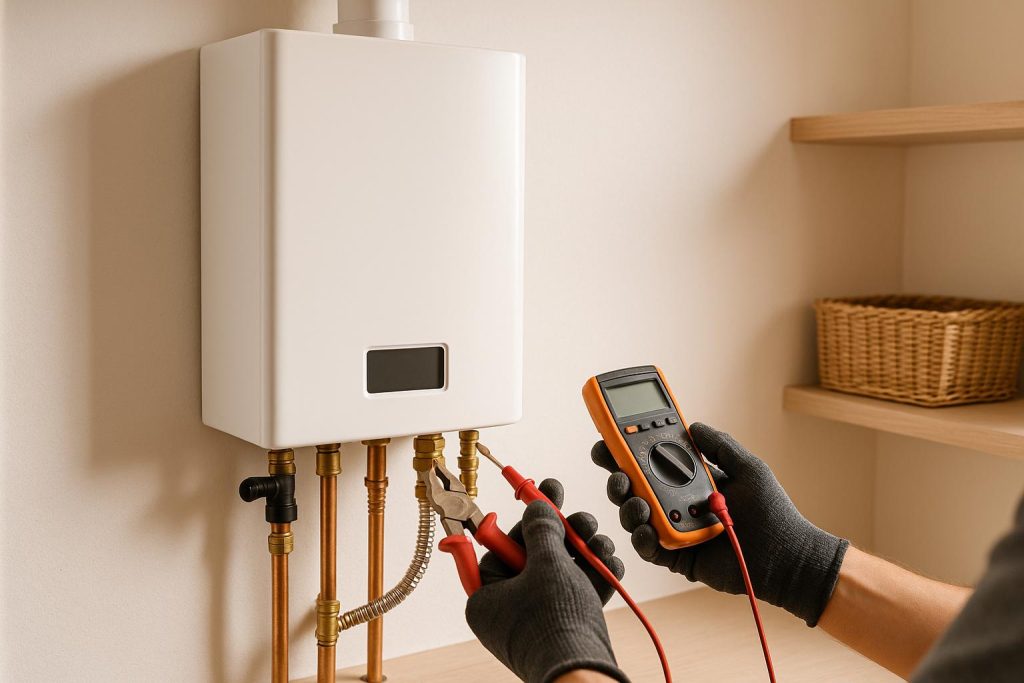
A water heater temperature and pressure relief valve (T&P valve) is a crucial safety component that helps prevent the buildup of excessive pressure and temperature inside a water heater.
Here’s a brief summary of what you should know about a T&P valve:
- Safety Function: The T&P valve is designed to release water from the water heater if the temperature or pressure inside the tank exceeds safe levels. This prevents the tank from exploding or rupturing due to excessive pressure buildup.
- Location: Typically, the T&P valve is located on the side or at the top of the water heater tank, with a discharge pipe that extends down to safely direct hot water away from the heater and into a drain or floor.
- Temperature Setting: The T&P valve is factory-set to open when the water temperature reaches around 210°F (99°C) or if the pressure exceeds 150 psi (pounds per square inch). These settings are well above normal operating conditions.
- Regular Testing: It’s essential to test the T&P valve periodically to ensure it functions correctly. You can do this by lifting the lever on the valve briefly to release a small amount of water. If water flows and then stops when you release the lever, the valve is working. Be cautious, as the released water can be hot.
- Replacement Period: T&P valves have a lifespan, and they can become less reliable over time. It’s a good practice to replace the T&P valve every three to five years or as recommended by the manufacturer.
- Proper Installation: The T&P valve and its discharge pipe must be installed correctly to ensure safety. The discharge pipe should be made of heat-resistant material and should terminate near the floor or drain to prevent scalding.
- Leakage or Dripping: If you notice consistent dripping or leakage from the T&P valve’s discharge pipe, it may indicate a problem. This could be due to high pressure, overheating, or a faulty valve. It’s essential to address such issues promptly.
- Do Not Block or Cap: Never cap or block the discharge pipe of the T&P valve. Doing so can lead to dangerous pressure buildup in the water heater and potential catastrophic failure.
- Professional Maintenance: If you’re unsure about the condition of your T&P valve or encounter any issues, it’s best to consult a professional plumber for inspection, testing, and replacement if necessary.
How Does a Temperature and Pressure Relief Valve Work?
A T&P valve is one of those home accessories that should only come into effect/use when something is wrong. It is usually installed for safety purposes, but it is not something you want to see being triggered on and off all the time.

A T&P valve has 2 sensors, one for the pressure and the other for temperature. When the temperature and pressure inside the water heater exceeds the valve’s rating, the water pushes a seat/disc in the valve which in return compresses a spring, allowing water to drip out of the valve until safe conditions are restored.
Different home plumbing systems work differently. If you have a closed-loop system, your water heater has the potential to explode when the valve fails to open. On the other hand, a house with an open system will be safe even when the T&P valve fails to open.
A closed-loop system describes a condition where water in the house can only flow in one direction, due to the presence of a check valve or pressure reducing valve (PRV). The opposite is what describes an open system.
With an open system, expanding water from a water heater can flow back through the cold-water supply pipe thereby bringing down the pressure and temperature of the water in the water heater. If you have a closed-loop system and unfortunately the T&P valve fails, the excess pressure and temperature will have nowhere to go, unless there is an immediate demand for hot water.
If you have a closed-loop system and want to have a back up for the T&P valve, consider installing a water heater expansion tank, also known as a thermal expansion tank.

A water heater expansion tank is a small tank (about 2 gallons in size) with an air bladder inside, installed on the water heater’s cold-water supply pipe, between the shut off valve and the water heater.
The tank has 2 sections. The upper part is a balloon-like bladder, whose air pressure should be equal to that of the incoming cold water. Its lower compartment is filled with the incoming cold water.
When water in the heater starts to heat up and expand, it flows back to the expansion tank, a move which compresses the air in the bladder instead of leaking out through the T&P valve. In some areas a water heater expansion tank is required by code.
Please not that if you have a hot water recirculation pump/system in your home then you have a check valve which makes your plumbing system close-looped. You will therefore need to install a thermal expansion tank.
People who use water from a well and have a check valve between the pressure tank and the water heater also have a closed-system. A water heater expansion is therefore needed in the house as well.
How to Test a TPR Valve
So, how do you know if your water heater temperature and pressure relief valve is bad, or if it is working as designed? It is actually very easy.

Lift off the lever on the P&T valve gently and check if water drains from the discharge pipe. If water is discharged from the tube when you lift the lever then the valve is working properly. On the other hand, if no water flows out the valve is faulty and will need to be replaced as soon as possible.
What causes a water heater temperature and relief valve to fail? The number 1 cause for a failed T&P valve is minerals deposits especially in areas with hard water which causes it to get stuck. A sticky valve is very unsafe, especially if you have no water expansion tank and have a closed-loop system.
The main reason you need a discharge tube installed on the T&P valve is to direct the hot water/steam downwards and hence safely, instead of it blowing straight on your face. As you test the valve make sure that you are wearing safety boots to prevent your scalding your feet.
Why is my T&P Valve Leaking?
There are 3 scenarios which can lead to a leaking water heater temperature and pressure relief valve:
- The water temperature and pressure in the water heater are too high, and the valve is just doing its job.
- The valve is faulty or not properly installed.
- The water heater expansion tank is waterlogged.
A waterlogged expansion tank happens when the bladder/diaphragm is raptured and as a result the tank fills with water. Since unlike air water cannot be compressed, the water heater will have nowhere to discharge the extra water pressure other than via the P&T valve.
To check if the water heater expansion tank is waterlogged or not, remove the cap at the top and try to bleed off air from the air inlet valve by pressing it down with a finger. If air flows out then the tank is ok.
When you attempt to bleed out air from the tank but instead water flows out, the expansion tank is waterlogged and will need to be replaced. A water heater expansion tank lasts for 5 to 10 years or even longer depending on how well it is maintained.
After confirming that the tank is not waterlogged, the other thing you can do is to check the pressure of the air in the bladder. Connect pressure gauge and compare it to that of the incoming cold water.
If the air pressure in the tank is too low then water is bound to leak from the T&P valve as there will be minimal compression. Use an air compressor or bicycle pump to add air into the tank until it is equal to that of the incoming cold water (usually between 40 and 70 psi).
Also Read: Why is my water heater leaking from the bottom?
How to Replace a Water Heater Temperature and Pressure Relief Valve.
If you have come to the conclusion that your water heater T&P valve is faulty, replacing it is easy and you don’t even need to call a plumber. You just need to buy a new replacement valve which costs between $20 and $30.
The one thing you need to be sure of is the size of valve you need to buy. There are usually 2 sizes of T&P valves; ¾ and ½-inch valves. If you are not sure which size you have, look for a tag on your old valve and you will find all of its specifications there.
Here is how to replace a water heater T&P valve:
- Turn off the cold-water pipe shut off valve.
- If you have an electric water heater, turn off its power at the circuit breaker. Turn off the thermostat to the pilot light if you have a natural gas-powered water heater.
- Attach a garden to the water heater drain valve and direct its other end to a floor drain or out into the driveway.
- Open the drain valve using a flathead screwdriver.
- As the water heater drains, keep lifting and releasing the T&P valve to see if water is still flowing out. When water stops flowing out of the T&P valve, the water lever in the water heater will be lower that the valve, and you should then close the drain valve.
- Disconnect the discharge tube from the valve using a wrench. Put it away.
- Use the same wrench to also disconnect the valve from the water heater.
- Inspect that status of the water heater T&P valve threads. If there are mineral deposits or any other type of dirt scrub it off using a toothbrush or wire brush.

- Wrap Teflon tape in a clockwise direction round the new T&P valve threads (4-6 wraps) to help create a good seal.
- Thread the valve on the water heater, being careful not to cross the threads until it is hand tight. Tighten it more using the wrench, but make sure the drain is facing down.
- Connect the discharge tube to the valve and tighten it as well.
- Turn on the cold-water supply.
- Dash to the nearest hot water faucet and turn it on. This will help in flushing out air from the water tank, preventing an airlock.
- Watch the flow of water from the faucet. At first, water will be sputtering as air is being flushed out but as soon as all the air has been expelled a smooth flow of water will start. Turn off the faucet.
- Turn on the pilot light or electrical power at the circuit breaker.
And basically that is how to replace a water heater temperature and pressure relief valve. Remember that you should drain your water heater at least once or twice a year. As you do so, test the P&T valve as well to make sure it is working properly.





